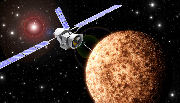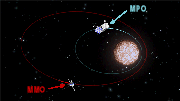 |
 |
 |
| Missions
|
||
         |
BepiColombo BepiColombo is named after Giuseppe (Bepi) Colombo (1920-84), a scientist who studied Mercury's orbital motion in detail and greatly contributed to the study of orbits and interplanetary travel. The BepiColombo will study and understand the composition, geophysics, atmosphere, magnetosphere and history of Mercury, the least explored planet in the inner Solar System. Itis a joint mission of the European Space Agency (ESA) and the Japan Aerospace Exploration Agency (JAXA). BepiColombo will provide the best understanding of Mercury to date. It consists of two individual orbiters: the Mercury Planetary Orbiter (MPO, built by ESA) to map the planet, and the Mercury Magnetospheric Orbiter (MMO, built by JAXA) to investigate its magnetosphere. The spacecrsft launched on Ariane 5 in 20 October 2018. The difficulty of reaching, surviving and operating in the harsh environment of a planet so close to Sun makes BepiColombo one of the most challenging long-term planetary projects undertaken by ESA so far. The spacecraft will have a six year interplanetary cruise to Mercury using solar-electric propulsion and gravity assists from the Moon, Earth, Venus and eventual gravity capture at Mercury. When BepiColombo reaches its destination (late 2026), the transfer module will be separated of the composit spacecraft (MMO & MPO). it will be only the second spacecraft to orbit Mercury in the history of planetary exploration. As the nearest planet to the Sun, Mercury has an important role in showing us how planets form. Mercury, Venus, Earth and Mars make up the family of terrestrial planets, each carrying information that is essential for tracing the history of the whole group. Knowledge how they originated and evolved is a key to understanding how conditions supporting life arose in the Solar System, and possibly elsewhere. As long as Earth-like planets orbiting other stars remain inaccessible to astronomers, the Solar System is the only laboratory where we can test models applicable to other planetary systems. Exploring Mercury is therefore fundamental to answer important astrophysical and philosophical questions such as 'Are Earth-like planets common in the Galaxy?' MPO carries a highly sophisticated suite of eleven scientific instruments, ten of which will be provided by Principal Investigators through national funding by ESA Member States and one from Russia: Laser Altimeter (BELA); Italian Spring Accelerometer (ISA), Mercury Magnetometr (MERMAG); Mercury Thermal Infrared Spectrometer (MERTIS); Mercury Gamma ray and Neutron Spectrometer (MGNS), Mercury Imaging X-ray Spectrometer (MIXS); Mercury Orbiter Radio science Experiment (MORE); Probing of Hermean Exosphere by Ultraviolet Spectroscopy (PHEBUS); Search for Exosphere Refilling and Emitted Neutral Abundance (SERENA); Spectrometers and Imagers for MPO BepiColombo Integrated Observatory System (SIMBIO-SYS) and Solar Intensity X-ray Spectrometer (SIXS). The Wigner RCP and SGF Co. Ltd. are participating in the realisation of SERENA/PICAM instrument. The SGF Ltd. has developed the Electrical Groung Support Equipment (EGSE). The SERENA instrument suite will study in-situ the composition, the vertical structure and the source of the deposit processes of the exosphere of Mercury. SERENA unit contains 4 sensors, SGF Ltd. has developed electrical ground support equipment for PICAM sensor . The PICAM mass spectometer has been developped in Austria.
09.October
2024
|
 BepiColombo and Mercury (Artwork)  BepiColombo at Mercury (Artwork) Integration of Protoflight model of BepiColombo  MPO and MMO orbits at Mercury (Artist's view) |